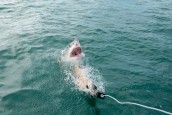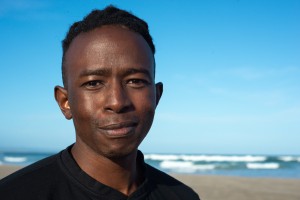It’s summer. This means it’s time for vacations, heat waves, and National Geographic’s SharkFest. SharkFest celebrates its tenth anniversary this year, with nearly thirty hours of new programming spread over four weeks.
First up is CAMO SHARKS, premiering Sunday, July 10, at 10 PM on National Geographic, then debuting on Disney XD on July 16, and Nat Geo Wild on August 1.
In CAMO SHARKS, shark scientists Dr. Ryan Johnson and PhD candidate Gibbs Kuguru investigate whether Great White sharks can change their color to blend in better with their surrounds. The duo also investigates new coloration in rare black-tipped reef sharks.
Kuguru gets on a Zoom call to talk all things CAMO SHARKS. Originally from Kenya, he came to the U.S. to go to medical school to become a doctor. However, the training made him realize, “I didn’t want to do that. So, my supervisor at the time actually sent me this bulletin that said, ‘Come dive with sharks in South Africa.’ I had two options at that point, start studying for my MCAT or get in the water, and I chose the sharks. So, that’s how that story began, and is still going on. I have no regrets – and [still have] all of my fingers,” he laughs.
The South African adventure was life-changing for Kuguru. “I had no prior experience with sharks, I wasn’t a diver, I didn’t swim very well, and I actually had a bit of a fear of sharks. Working with sharks, from the very first day, I knew that my fears were unfounded, and it just made me want to continue to be in that environment and work with them, because they really left an impression on me, and I began to love these animals that I initially feared. I think I learned to love sharks by working with them.”
Kuguru is based in the Netherlands, which is not known as a major center of shark activity. “The Netherlands is not really a shark hot spot,” Kuguru relates, “but they do really excel in science-based research, which is why I decided to come here, because I felt like this was going to be the place where I can be the most successful as a scientist, and the university that I’m at has a really strong specialty in genetic research. And I’m a geneticist, so I thought, ‘Okay, this is actually the best possible place for me to grow my skills.’”
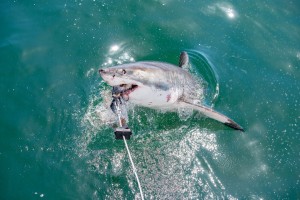
A Great White breaches the water with the bait lure in CAMO SHARKS | ©2022 National Geographic/Fiona Ayerst
Is finding out whether Great Whites can change color important to know in of itself, or is the information a puzzle piece in a larger question?
“I think trying to define importance in the scale of research is quite subjective,” Kuguru replies. “I think oftentimes we give importance to the things we think are important to us, but are not necessarily all that is important, and that’s one of the things that I love about CAMO SHARKS. It gave us an opportunity to actually explore a different realm of shark research that hadn’t been fully fleshed out yet.”
Kuguru points out, “Research oftentimes focuses on a prevailing agenda – what we ‘should’ research, what’s the ‘most important’ – and we leave the fun and creative subjects, which I believe are equally important, on the wayside. One thing I want people to take away from CAMO SHARKS is that you can do research that is purely for creativity, because that’s really what I think it’s all about. The pursuit of knowledge for the sake of knowledge, that is to me the most beautiful thing.”
CAMO SHARKS began conceptually, Kuguru says, when “I found these sharks in the Maldives that had developed this very peculiar skin pattern. That led me down this rabbit trail of looking for all the different adaptations that sharks have in relation to their skin, also, just regular skin adaptations throughout the animal kingdom. That’s when we caught onto the idea that sharks may be able to do other things with their skin that we didn’t previously know about, and that’s when we built up that investigation.”
Some marine life – octopuses, for example – are famous for their ability to change color. However, when an octopus is avoiding a predator, it makes sense they would want to blend in with the rocks and coral. Likewise, when an octopus is acting as a predator, they tend to sit and wait rather than chase after prey, so camouflage makes sense there as well.
However, Great Whites are known for their strength and speed. Why would such a large, powerful animal also need to change its shading?
“My idea of why sharks would need this camo adaptation,” Kuguru explains, “is because the predator/prey interaction is ultimately an arms race. Intel is one of the things that can give you an edge on your foe. So, if you have a prey species that’s particularly good at seeing things, you’d want to be able to hide from them if you were thinking about eating them. And I think that’s part of the suite of tools Great Whites have at their disposal, especially when they’re trying to hunt seals. Essentially, Great White sharks are using this camouflage effect to get an edge on the seals in a predation setting.”
With the black-tipped reef sharks in the Maldives, camouflage seems to be a response to human predation and pollution, and may indicate disease. “The over-fishing that that population had experienced was heavy for a number of years, and it eventually led to a shrinking of the population, to the point where they had started to inbreed. And this inbreeding caused a recessive type of alleles [types of DNA sequences] to rise up into the general population, and that’s what we’re seeing now, with the leucism.”
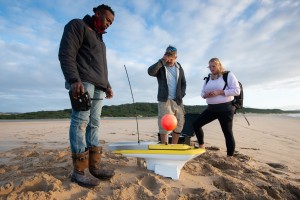
The team gets ready for color testing with a remote control boat in CAMO SHARKS | ©2022 National Geographic/Fiona Ayerst
With the Great Whites, though, the ability to change color is purely an advantage. “With the Great Whites, it seems to be a unique adaptation. Unlike with the black-tips, where it seems like this adaptation does have some drawbacks, we are pretty sure that this is just something that the Great Whites have essentially hidden away from us until recently.”
Does Kuguru and Johnson’s research indicate if the sharks are changing hue consciously or instinctively?
“I would say it’s more instinctive,” Kuguru replies, “primarily because of the hormones that mediate the skin changes. I think many of the skin changes are involuntary. For example, with the adrenaline, what ends up happening is, the skin cells end up shrinking and the shark becomes pale. I think this could also help the shark develop more muted color tones, so that when they do escape danger, for example – a boat, a fisherman, or even an orca – they dive really deep down, and then their color tone matches the color tone of the bottom of the ocean, so then they’re nearly indistinguishable from the surroundings.”
Much of CAMO SHARKS was shot in South Africa’s Mossel Bay, where fish attract huge amounts of seals, which in turn attract many Great Whites. “Mossel Bay is quickly becoming the best place to see Great Whites in the world,” Kuguru observes. “It is one of those unique situations where you have a warm water current coming in there, you’ve got juvenile sharks, you’ve got seals, and that whole mix becomes like a natural magic, where there are just always Great Whites, always in the same place, and that gives us as scientists a really amazing opportunity to be able to see these animals almost on a daily basis. So, if you ever get a chance, come to Mossel Bay.”
There is a lot of dramatic footage in CAMO SHARKS of Kuguru in a shark cage, attempting to get skin samples from live Great Whites with a little device at the end of a long pole. At one point – spoiler alert – one of the prospective test subjects seems to lose patience, and chomps with big Great White shark jaws on the top of the cage’s frame.
Despite what it looks like to most viewers, “That is not a shark attack,” Kuguru states. “This was a very low level of aggression. Sharks have to try to see and feel their environment, but the only tool they have at their disposal is their mouth. So, they literally go around and feel things with their mouth, and unfortunately, sometimes when they’re exploring people, it ends up being fatal for the person they do end up biting. But it’s not aggressive, and I think if you actually see a shark hunting, they can really ramp up the ferocity when they do want to capture a prey item. That shark, when I was in the cage, it simply bit on it, felt, ‘This is not something I want to eat, or to play with,’ and then quickly swam away to show that it actually was very disinterested.”
When we see Kuguru in the water in the shark cage, who is filming him? “We do have a film crew with us, and sometimes one of the crew members has to get out of the cage and do the filming.” Just to be clear – that’s a camera operator, hands full of equipment, with no cage, in open water with Great Whites. Of the crew, Kuguru says with an admiring laugh, “They have balls of steel.”
Does being observed by a film crew while at work change anything for Kuguru? “It is quite strange to have a film crew there, watching your every move, and it really makes you conscious about what you’re doing. But I’m also very aware of the fact that this program is going out to many people, and that I do want to show the work that shark scientists do, and also, the sharks themselves, in a good light. So, you quickly get over [being self-conscious about the camera], but it doesn’t mean that the pressure isn’t on all the time.”
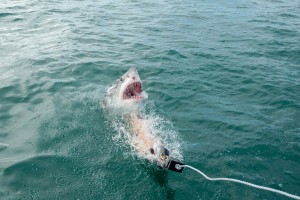
Chumming to attract Great Whites to be photographed as part of the color testing experiments in CAMO SHARKS | ©2022 National Geographic/Fiona Ayerst
Kuguru’s advice for anyone who does have the misfortune of being closely investigated by a shark: “More often than not, once the shark has you, you really are at the mercy of the animal. Most of the time, sharks do release people, because they also realize, ‘This is not our prey item, it doesn’t taste like what we like to eat.’ But it is good practice in any kind of trauma situation to try and mitigate the effects of that trauma, and bleeding out is usually what happens to most people. So, making sure that you remain as calm and still as possible whilst help is arriving is the best way to try and stay alive. I think it’s also important to realize that this is their environment. The ocean is where these sharks live. We need to respect that, and we also need to learn how to live with them. Many of these things can be mitigated by just awareness.”
Sharks, of course, have much more to fear from humans than humans have to fear from them. In CAMO SHARKS, Kuguru and Johnson are presented with a dead juvenile Great White that is said to have been killed in a fishing accident.
In South Africa, Kuguru says, Great White sharks are a protected species, but they are sometimes victims of illegal killing. “It is incredibly heartbreaking every time it does happen, because oftentimes, it’s done needlessly, and sometimes for financial gain. It’s never easy when you see your first dead Great White, and it doesn’t get any easier after you see your tenth, twentieth, whatever. It’s always just, why? Why does this have to happen? More often than not, when sharks are killed in these fishing incidents, if the people are caught, then the government will seize the shark, and also make sure that they don’t sell the valuable parts of the animal, which are the jaws, the fins, and the liver, which some people use for medicinal purposes, although I think it’s more of a snake oil-type situation [with no actual medicinal benefit].”
Is one of the purposes of CAMO SHARKS to get viewers more interested in shark conservation? “Yes. Certainly, I hope that people do feel more motivated to protect sharks by watching CAMO SHARKS. But also, being able to see what it’s like to experience a day in the life of a shark scientist. This program – it really was us doing all that stuff – making mistakes, figuring out what works. Even on the last day, when we were in the lab, we didn’t know if that experiment was going to pan out. We’re really out there, doing the work, and that’s what I want people to see. And I hope it inspires the next generation of shark researchers to take up the mantle.
“I would encourage people, as they watch CAMO SHARKS, to learn to see these animals in a different light. They are ferocious, wild animals. But they’re also beautiful, and they are part of our environment, and also part of this beautiful, rich tapestry of life. They have just as much of a stake in the health and progression of our environment as we do. So, I want people to see sharks as ‘us,’ and not ‘the other.’”
What is Kuguru working on now? “At the moment, I’m analyzing a whole bunch of shark samples at our laboratory here in the Netherlands, to find out what unique elements in the DNA can tell us about how these sharks are surviving and withstanding the negative effects of humanity. That’s really what all of my research is about, is finding out how these animals survive in the face of people.”
Does Kuguru have a favorite shark species? “Each of these shark species, to me, has so many unique points to them. I love looking at the black-tips, and their social capacity to teach each other, and to learn. But then you see a Great White, and all these different personality types that [they have], and you’re like, ‘Man, how can you not love them?’ I’ve met so many sharks over the years that have such different and boisterous and engaging personalities, that’s made me think about these animals a little bit differently. Because they’re not just fish in the way we think about them, they are individuals, and that perspective is something I think only a Great White can give you.”
Follow us on Twitter at ASSIGNMENT X
Fan us on Facebook at ASSIGNMENT X
Article Source: Assignment X
Article: SHARKFEST: CAMO SHARKS: Researcher Gibbs Kuguru on new Nat Geo Wild project – Exclusive Interview
Related Posts:




